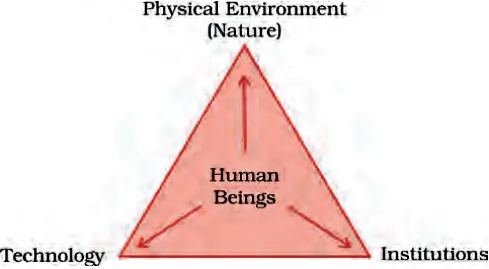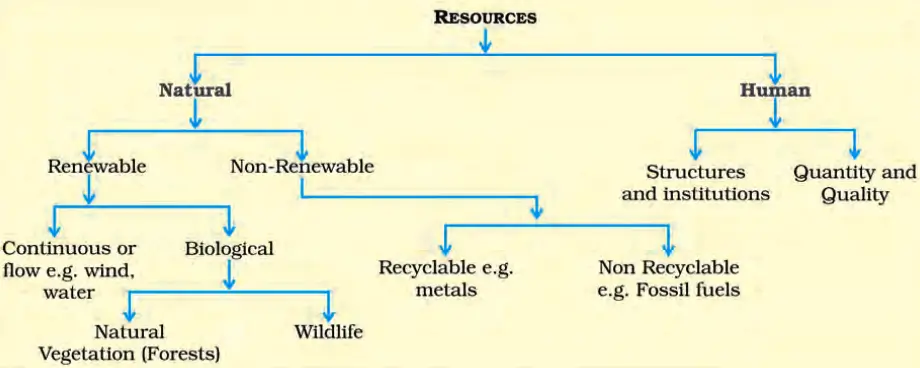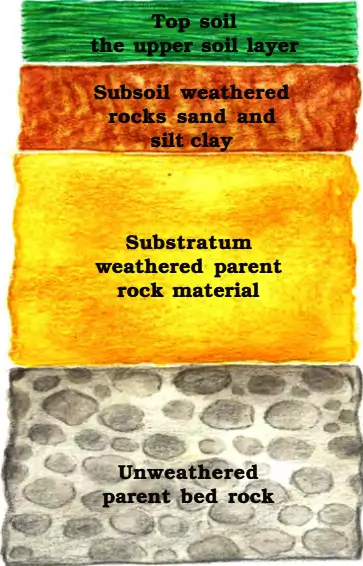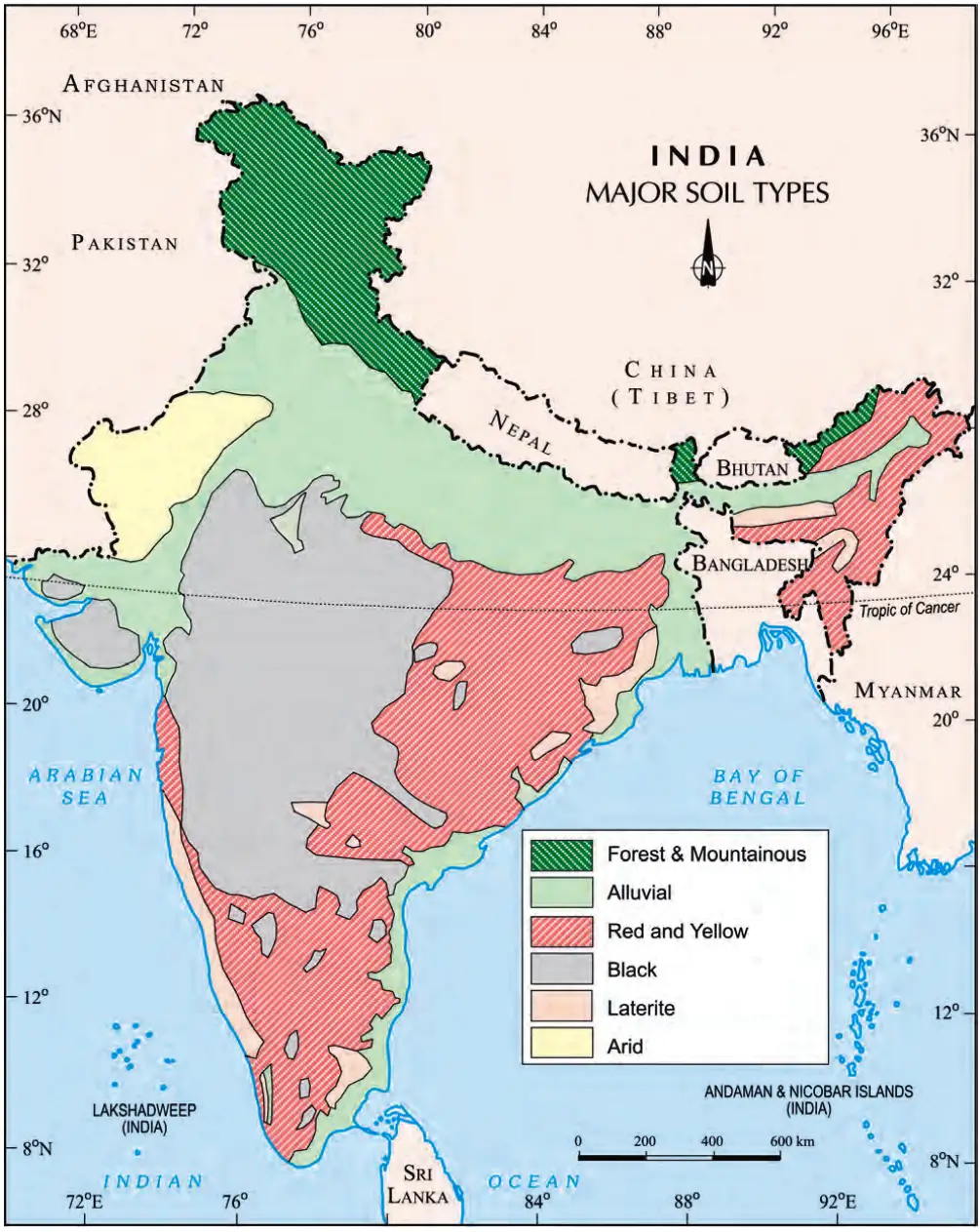Revision Notes for Class 10 Geography – Chapter 1 Resources and Development
Are you confused on Revision Notes? Revision Notes for class 10 Geography – Chapter 1 Resources and Development is the right place to refer.
Resources
Resources are everything available in the environment which can be used to satisfy human needs provided, it is technologically accessible, economically feasible and culturally acceptable. Human beings interact with nature through technology and create institutions to accelerate their economic development.
Resources are a function of human activities. Human beings themselves are essential components of resources. They transform material available in our environment into resources and use them.
Classification of Resources:
- On the basis of Origin – biotic and abiotic.
- On the basis of Exhaustibility – renewable and non-renewable.
- On the basis of Ownership – individual, community, national and international.
- On the basis of Status of Development – potential, developed stock and reserves.
Types of Resources
On the basis of Origin:
- Biotic Resources: These resources are obtained from biosphere and have life such as human beings, flora and fauna, fisheries, livestock etc.
- Abiotic resources: These are things which are composed of non-living things such as rocks and metals.
On the basis of Exhaustibility:
- Renewable (or Replenishable) Resources: These are resources which can be renewed or reproduced by physical, chemical or mechanical processes. For example – solar, wind energy, water, etc. They may further be divided into continuous or flow.
- Non-Renewable Resources: These occur over a very long geological time. For example – Minerals, fossil fuels etc. Some of them like metals are recyclable and some like fossil fuels cannot be recycled.
On the basis of Ownership:
- Individual Resources: These are also owned privately by individual. Such as Plantation, pasture lands, ponds, water in wells etc.
- Community Owned Resources: These are resources that are accessible to all the members of the community. For example – Village commons (grazing grounds, village ponds etc.).
- National Resources: Technically, all the resources belong to the nation. All the minerals, water resources, forests, land within the political boundaries and oceanic area up to 12 nautical miles (22.2 km) from the coast termed as territorial water and resources therein belong to the nation.
- International Resources: The oceanic resources beyond 200 nautical miles of the Exclusive Economic Zone belong to open ocean and no individual country can utilise these without the concurrence of international institutions. (ISBA, UNCLOS).
On the basis of the Status of Development:
- Potential Resources: These are those resources which are found in a region but they have not been utilised. For example – The Western parts of India have not developed the wind and solar energy properly despite having enormous potential.
- Developed Resources: These are resources which are surveyed and their quality and quantity have been determined for utilisation. Their development depends on technology and level of their feasibility.
- Stock: They are the materials in the environment which have the potential to satisfy human needs but human beings do not have the appropriate technology to access these. For example, Human beings do not the advanced technology to utilize hydrogen from water as a source of energy.
- Reserves: They are the subset of the stock which can be put into use with the help of existing technical ‘know-how’ but their use has not been started. For example, River water can be used for generating hydroelectric power but it is being utilised only to a limited extent.
Development of Resource:
Resources are vital for human survival as well as for maintaining the quality of life. Human beings considered resources are free gift which resulted into indiscriminate use of the resources.
- Depletion of resources for satisfying the greed of a few individuals.
- Accumulation of resources in few hands which divided the society into two segments i.e. haves and have nots or rich and poor.
- Indiscriminate exploitation of resources has led to global ecological crises such as, global warming, ozone layer depletion, environmental pollution and land degradation.
Resource Planning:
Resource planning is essential for sustainable existence of all forms of life. Sustainable existence is a component of sustainable development.
- Planning is the widely accepted strategy for judicious use of resources. It has importance in a country like India, which has enormous diversity in the availability of resources.
- There are some regions which can be considered self sufficient in terms of the availability of resources and there are some regions which have acute shortage of some vital resources.
- For example – The state of Rajasthan is very well endowed with solar and wind energy but lacks in water resources.
- A balanced resource planning at national, state, regional and local level is necessary.
Resource Planning in India:
- Resource Planning is a complex process which involves:
- Identification and Inventory of resources: Across the regions of the country. It involves surveying, mapping and qualitative and quantitative estimation and measurement of the resources.
- Evolving a Planning Structure: It is endowed with appropriate technology, skill and institutional set up for implementing resource development plans.
- Matching the resource development plans with overall national development plans.
- India has been working for resources planning since first five year plan.
- Resources can contribute to development only when they are accompanied by appropriate technological development and institutional changes.
- In India, development, in general, and resource development in particular does not only involve the availability of resources, but also the technology, quality of human resources and the historical experiences of the people.
Conservation of Resources:
Then irrational consumption and over-utilisation of resources may lead to socio-economic and environmental problems. To overcome this problems resource conservation at various level is important.
Land Resources:
- Land is natural resource of utmost importance and supports natural vegetation, wild life, human life, economic activities, and transport and communication systems.
- In India 43 per cent of the land area is plain, 30 per cent Mountains and about 27 per cent of the area of the country is the plateau region.
Land Use Pattern:
It is determined by:
- Physical factors: Physical factors like topography, climate, soil types.
- Human factors: It includes population density, technological capability and culture and traditions etc.
Categories of Land use pattern:
- Forests
- Land not available for Cultivation:
- Barren and waste land.
- Land put to non-agricultural uses, e.g. buildings, roads, factories, etc.
- Other Uncultivated land (excluding fallow land):
- Permanent pastures and grazing land.
- Land under miscellaneous tree crops groves (not included in net sown area).
- Cultural waste land (left uncultivated for more than 5 agricultural years).
- Fallow Lands: Fallow land includes,
- Current fallow – (left without cultivation for one or less than one agricultural year).
- Other than current fallow-(left uncultivated for the past 1 to 5 agricultural years).
- Net Sown area: The area sown more than once in an agricultural year is called net sown area and it is also known as gross cropped area.
Land Use Pattern in India:
- Variation of Net Sown Area in states: It is over 80 per cent of the total area in Punjab and Haryana and less than 10 per cent in Arunachal Pradesh, Mizoram, Manipur and Andaman Nicobar Islands.
- Forest Area: It is far lower than the desired 33 per cent of geographical area as outlined in the National Forest Policy (1952).
- Waste Land: It includes rocky, arid and desert areas and land put to other non-agricultural uses includes settlements, roads, railways, industry etc.
- Land Conservation: Continuous use of land over a long period of time without taking appropriate measures to conserve and manage it has resulted in land degradation.
Land Degradation and Conservation Measures:
- Land Degradation: It is caused by the Mining, over grazing, over irrigation, water logging, formation of dust which prevents infiltration of water, etc.
- Conservation of Land Degradation: Some of the ways are – Afforestation and proper management of grazing, Planting of shelter belts of plants, control on over grazing and stabilisation of sand dunes by growing thorny bushes etc.
Soil as a Resource:
Soil is the most important renewable natural resource and is a living system. The important factors in its formation are Relief, parent rock or bed rock, climate, vegetation and other forms of life and time. It also consists of organic (humus) and inorganic materials.
Classification of Soils:
The soils in India are classified into different types on the basis of the factors responsible for soil formation, colour, thickness, texture, age, chemical and physical properties.
Alluvial Soils:
- Source: These have been deposited by three important Himalayan river systems – the Indus, the Ganga and the Brahmaputra.
- Regions: It covers entire northern plains, extended through narrow corridor into Gujarat and Rajasthan, eastern coastal plain particular in deltas of the Mahanadi, the Godavari, etc.
- It consists of various proportions of sand, silt and clay. The inland soil near the river valley appears bigger in size and in upper reaches of the river valley, near the place of break of slope, soil are coarse as found in in piedmont plains such as Duars, Chos and Terai.
- Classification based on age: These can be classified as old alluvial (Bangar) and new alluvial (Khadar). The bangar soil has higher concentration of kanker nodules than the Khadar. The khadar has more fine particles and is more fertile than the bangar.
- Chemical components: Potash, phosphoric acid and lime.
- Important crops: Sugarcane, paddy, wheat and other cereal and pulse crops.
- Soils in the drier areas are more alkaline.
Black Soil:
- These soils are black in colour and are also known as regur soils. It is ideal for growing cotton and is also known as black cotton soil. It is made up of lava flows.
- The most important factors for its development are climatic conditions and parent rocks.
- It is made up of extremely fine i.e. clayey material. They are rich in soil nutrients, such as calcium carbonate, magnesium, potash and lime and poor in phosphoric contents.
- Regions: It cover the plateaus of Maharashtra, Saurashtra, Malwa, Madhya Pradesh etc. and extend in the south east direction along the Godavari and the Krishna valleys.
- They are well-known for capacity to hold water. It is sticky when wet and difficult to work on unless tilled immediately after the first shower or during the pre-monsoon period.
Red and Yellow Soils:
- Red soil develops on crystalline igneous rocks in areas of low rainfall in the eastern and southern parts of the Deccan plateau.
- These soils develop a reddish colour due to diffusion of iron in crystalline and metamorphic rocks. It looks yellow when it occurs in a hydrated form.
- Regions: They are found in parts of Odisha, Chhattisgarh, southern parts of the middle Ganga plain and along the piedmont zone of the Western Ghats.
Laterite Soil:
- Laterite has been derived from the Latin word ‘later’ which means brick.
- It develops under tropical and subtropical climate with alternate wet and dry season and result of intense leaching due to heavy rain. It is mostly deep to very deep acidic.
- They are lacking in plant nutrients.
- Presence of Humus: It is humus rich where it support deciduous and evergreen forests whereas it humus poor when under sparse vegetation and in semi-arid environment.
- Areas: They are found in southern states, Western Ghats region of Maharashtra, Odisha, some parts of West Bengal and North-east regions.
- This soil is very useful for growing tea and coffee. Red laterite soils in Tamil Nadu, Andhra Pradesh and Kerala are more suitable for crops like cashew nut.
Arid Soils:
- Arid soils range from red to brown in colour and are generally sandy in texture and saline in nature and sometime salts can be obtained from it. Soil lacks in humus and moisture.
- Lacks humus and moisture: Due to the dry climate, high temperature, evaporation is faster.
- The lower horizons of the soil are occupied by Kankar because of the increasing calcium content downwards. Kankar formation prevents water infiltration.
- With proper irrigation this soil can be used for cultivation.
Forest Soil:
- These soils are found in the hilly and mountainous areas where sufficient rain forests are available.
- They are loamy and silty in valley sides and coarse grained in the upper slopes.
- In the snow covered areas of Himalayas, these soils experience denudation and are acidic with low humus content.
- The soils found in the lower parts of the valleys particularly on the river terraces and alluvial fans are fertile.
Soil Erosion and Soil Conservation:
Soil Erosion: It is the denudation of the soil cover and subsequent washing down. The processes of soil formation and erosion go on simultaneously and generally there is a balance between the two.
Reasons for Soil Erosion:
- Natural Reasons: It includes natural forces like wind, glacier and water. The running water cuts through the clayey soils and makes deep channels called as gullies, due to gullies the land becomes unfit for cultivation and is known as bad land. In the Chambal basin such lands are called ravines.
- Human Reasons: Deforestation, over-grazing, construction and mining etc.
Various Types of Soil Erosion:
- Sheet Erosion: Sometimes water flows as a sheet over large areas down a slope which wash away the top soil.
- Wind Erosion: Wind blows loose soil off flat or sloping land.
- Soil erosion is also caused due to defective methods of farming. Like- Wrong ploughing.
Measures to Reduce Soil Erosion:
- Contour Ploughing: Ploughing along the contour lines which decelerate the flow of water down the slopes.
- Terrace Cultivation: Steps can be cut out on the slopes making terraces.
- Strip Cropping: Strips of grass are left to grow between the crops which breaks up the force of the wind.
- Shelter Belt: Rows of trees planted in lines to create shelter.
Interesting points
- “There is enough for everybody’s need and not for any body’s greed.” – Gandhiji.
- In India, Land use data is available only for 93 per cent of the total geographical area because:
- The land use reporting for most of the north-east states except Assam has not been done fully.
- Moreover, some areas of Jammu and Kashmir occupied by Pakistan and China have also not been surveyed.
- India has got the right to mine manganese nodules from the bed of the Indian Ocean from that area which lies beyond the exclusive economic zone (EEZ).
- Sustainable development: Sustainable economic development means ‘development should take place without damaging the environment, and development in the present should not compromise with the needs of the future generations.’
- At the international level, the Club of Rome advocated resource conservation for the first time in a more systematic way in 1968. Gandhian philosophy was presented by Schumacher in his book Small is Beautiful.
- Brundtland Commission Report, 1987: This report introduced the concept of ‘Sustainable Development’ and advocated it as a means for resource conservation, which was subsequently published in a book entitled Our Common Future.
- Rio de Janeiro Earth Summit, 1992:
- It was the first International Earth Summit which was convened for addressing urgent problems of environmental protection and socioeconomic development at the global level.
- The assembled leaders signed the Declaration on Global Climatic Change and Biological Diversity.
- The Rio Convention endorsed the global Forest Principles and adopted Agenda 21 for achieving Sustainable Development in the 21st century.
- Agenda 21: It is the declaration signed by world leaders in 1992 at the United Nations Conference on Environment and Development (UNCED), which took place at Rio de Janeiro, Brazil. It aims at achieving global sustainable development.









